The 1917 Wheat penny is part of the iconic Lincoln Wheat cent series minted from 1909 to 1959. Despite being called a “penny,” its official designation is a one-cent piece.
These coins are generally worth more than their face value, but they are fairly common compared to some rarer issues. However, specific varieties like the 1917 Double Die Obverse (DDO) penny can be highly valuable.
1917 Wheat Penny Value Chart (for Brown Coins)
| Condition | 1917 (No Mint Mark) Penny | 1917 DDO Penny | 1917 D Penny | 1917 S Penny |
|---|---|---|---|---|
| Good (G) | $1 | $150 | $4 | $2 |
| Very Good (VG) | $1 | $260 | $6 | $2 |
| Fine (F) | $1 | $315 | $12 | $6 |
| Very Fine (VF) | $4 | $550 | $26 | $10 |
| Extra Fine (XF) | $6 | $1,400 | $38 | $22 |
| About Uncirculated (AU) | $12 | $1,600 | $48 | $32 |
| Mint State 60 (MS60) | $30 | $3,750 | $100 | $125 |
| Mint State 63 (MS63) | $50 | $8,500 | $140 | $225 |
👉 Note: The 1917 Double Die Obverse (DDO) penny is especially rare and can fetch thousands of dollars in mint condition.
History of the 1917 Wheat Penny
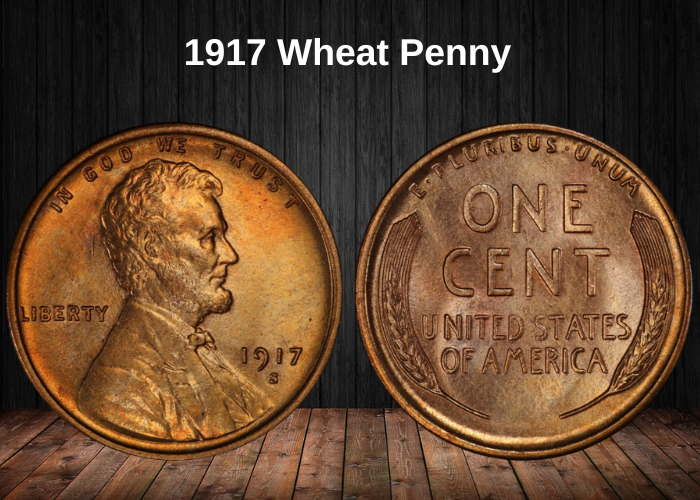
Many Americans, especially coin collectors, regard Lincoln Wheat pennies as some of the most significant national coins ever produced by the U.S. Mint. They hold historical importance as the first U.S. coins to feature a real person—Abraham Lincoln—and have remained a favorite among numismatists for decades.
1917 Wheat Penny Mintages
| Mint | Year | Mintage |
|---|---|---|
| Philadelphia | 1917 (No Mint Mark) | 196,429,785 |
| San Francisco | 1917 S | 32,620,000 |
| Denver | 1917 D | 55,120,000 |
| Total | / | 284,169,785 |
The 1917 Wheat penny follows the same design as others issued after 1910. However, the 1909 VDB pennies stand out because they featured designer Victor David Brenner’s (VDB) initials on the reverse, making them highly sought after.
Another notable variation occurred during World War II, when the U.S. Mint used recycled shell casings to produce pennies.
Although the Lincoln Memorial cent replaced the Wheat penny in 1959, and the Shield cent followed later, Wheat pennies remain a treasured part of American numismatic history.
Features of the 1926 Wheat Penny
The 1917 Wheat pennies belong to the Lincoln cent series, minted from 1909 to 1958, based on Victor David Brenner’s iconic design. While they share the same appearance as other early Wheat pennies, certain variations and conditions make some 1917 pennies more valuable than the average.
The obverse of the 1917 Wheat penny
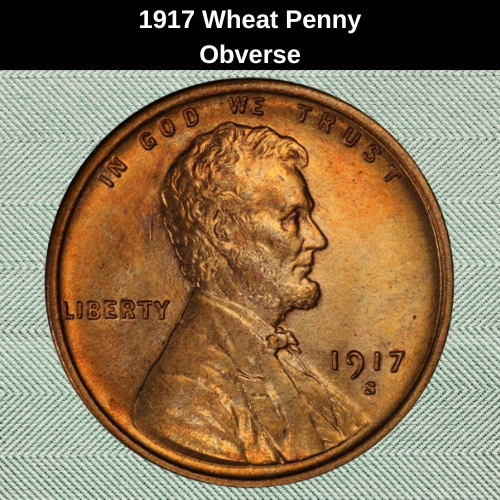
Victor David Brenner designed the obverse of the 1917 Wheat penny, featuring:
- A portrait of Abraham Lincoln in profile
- The date “1917” on the right side
- The word “LIBERTY” to the left of Lincoln
- The national motto “IN GOD WE TRUST” arching along the top
- A mint mark (D for Denver, S for San Francisco, or no mark for Philadelphia) below the date (if applicable)
The reverse of the 1917 Wheat penny
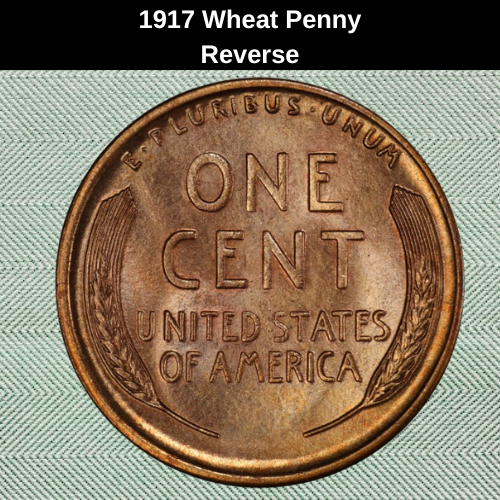
The reverse of the 1917 Wheat penny features:
- The denomination “ONE CENT” in large letters at the center
- “UNITED STATES OF AMERICA” below the denomination
- Two stylized wheat ears, one on each side, framing the central inscriptions
- The Latin motto “E PLURIBUS UNUM” (“From many, one”) curving along the top edge
1917 Wheat penny Details
The 1917 Wheat penny retains the same design and composition as other early Lincoln cents. Here are its detailed specifications:
- Face Value: One cent ($0.01)
- Shape: Round
- Thickness: 1.52 mm (0.0598 inches)
- Weight: 3.11 grams (0.11 ounces)
- Edge: Smooth (plain)
- Diameter: 19.05 mm (0.75 inches)
- Composition: 95% copper, with the remaining 5% being zinc or tin
This classic coin remains highly sought after by collectors due to its historical significance and durable copper composition.
Other features of the 1917 Wheat penny
The 1917 Wheat penny has a plain edge and a face value of one cent. It measures 19.05 mm (0.75 inches) in diameter and is composed of 95% copper, with the remaining 5% made of zinc or tin. Each coin weighs 3.11 g (0.1097 ounces) and has a thickness of 1.52 mm (0.0598 inches).
This classic design remains a sought-after piece among collectors due to its durability and historical significance.
1917 Wheat Penny Grading Guides
When determining the value of a 1917 Wheat penny, the condition and possible errors play a crucial role. Here’s a quick breakdown of how coins are graded, with higher grades indicating better preservation and often leading to higher values:
- 1 (Basal State-1): Very poor condition, barely identifiable.
- 2 (Fair): Heavily worn but still identifiable.
- 3 (Very Fair): Significant wear, but more details are visible.
- 4, 5, 6 (Good): Shows significant wear, but all basic details remain.
- 7, 8, 10 (Very Good): Noticeable wear, but all major design elements are legible.
- 12, 15 (Fine): Moderate wear, but clear details.
- 20, 30 (Very Fine): Some wear on high points but with most details sharp.
- 40 (Extremely Fine): Light wear on high points, almost no wear on other areas.
- 50 (About Uncirculated): Very light wear, close to uncirculated.
- 60 (Mint State): No wear at all, but may have minor imperfections from the minting process.
- 65 (Mint State): Near perfect, with minimal imperfections.
- 70 (Mint State): Flawless coin with no defects.
For an accurate evaluation, it’s recommended to consult with experts who can authenticate and grade your coin. This will give you a precise understanding of its value based on its grade, potential errors, and rarity.
1917 Wheat Penny Value Guides
Although a total of 284,169,785 pennies were minted in 1917 across three different mints, not all of these coins have endured through the years. This is especially true for those in the highest grades, which have become rare and valuable in today’s market.
1917 No Mint Mark Wheat penny Value
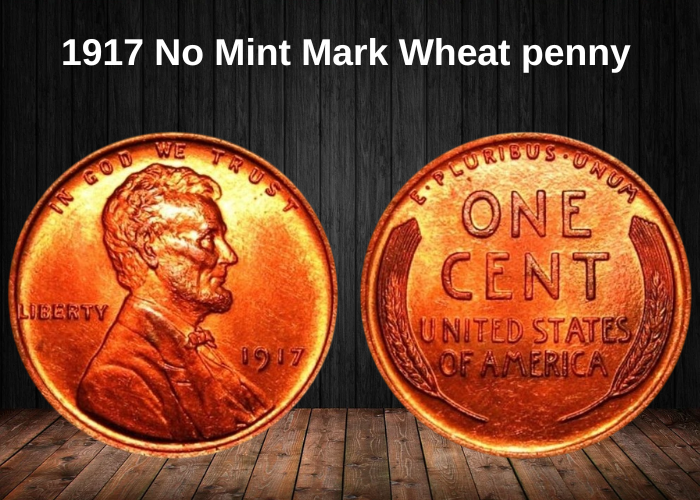
In 1917, a total of 196,429,785 Wheat pennies were minted in Philadelphia. These coins can be divided into three groups based on their collectability, ranging from the least to the most sought after.
- Brown-toned coins are the least desirable among collectors and therefore tend to have lower prices. Depending on their condition, you can expect to pay between $1 and $12 for a circulated coin.
- Mint state pieces are still relatively affordable, with prices ranging from $30 to $200. However, certain exceptions exist, such as the 1917 MS 66 brown penny, which sold for $1,125 in 2021.
- Red-brown coins are more collectible, with prices for MS 63 to MS 66 coins ranging from $80 to $500. A notable 1917 MS 66 RB penny even reached $1,293 at auction in 2013.
- Red coins are the most valuable of the 1917 pennies. For lower-ranked pieces (MS 63), expect to pay around $125, but prices rise significantly for higher-grade coins:
- MS 64: $275
- MS 65: $525
- MS 66: $1,250
- MS 67: $5,250
- MS 68: $78,000
The most expensive 1917 MS 68 red Wheat penny fetched a remarkable $38,813 at auction in 2006.
1917 D Wheat penny Value
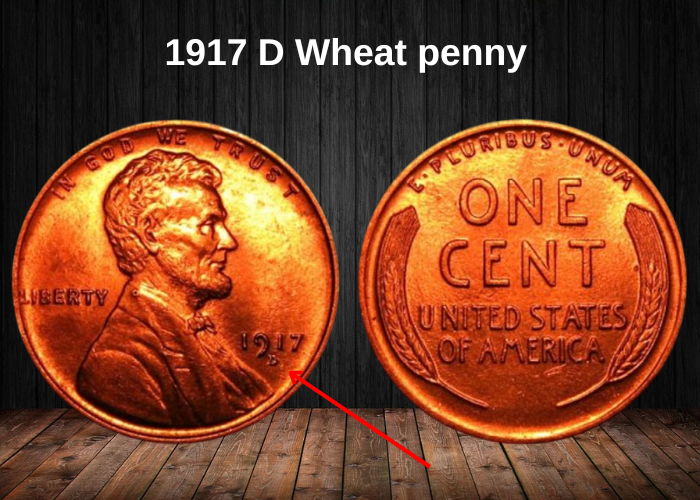
The Denver Mint struck 55,120,000 pennies in 1917, securing the second-highest mintage for that year. The value of these pennies can vary significantly based on their condition and mint mark.
- Brown coins with the “D” mint mark in circulated condition typically range from $1 to $45.
- Mint state coins (MS 60 to MS 65) are more expensive, with prices ranging from $100 to $550. A notable auction record for a 1917 D coin was set in 2010 when it sold for $1,725.
- Red-brown (RB) pennies are considerably more valuable:
- MS 63: $275
- MS 64: $475
- MS 65: $775
- MS 66 (rare): $1,900 to $3,000, with one red-brown penny selling for $3,600 in 2021.
- Red pennies are the most prized:
- MS 63: $350
- MS 64: $850
- MS 65: $1,850
- MS 66: A price of $10,500 may seem unrealistically high, but in 2005, a red 1917 D MS 66 penny sold for a record $21,275 at auction.
These coins, especially those in better condition and with the red color, are highly sought after by collectors.
1917 S Wheat penny Value

The San Francisco Mint’s 1917 penny mintage was the lowest of the three mints, with a total of 32,620,000 coins. While this is still a relatively high number, it makes the coins more common, especially in lower grades.
- Circulated brown coins typically range from $2 to $28 in value.
- Uncirculated coins (such as MS 60 to MS 65) are worth between $135 and $550. The auction record for a 1917 S brown penny with an MS 66+ grade was set in 2018, when it sold for an impressive $8,225.
- Red-brown (RB) pennies are more expensive, with values ranging from $125 to $1,200. Coins graded MS 65+ can reach as much as $3,600.
- Red pennies from the San Francisco mint are highly coveted by collectors:
- MS 63: $600
- MS 64: $1,600
- MS 65: $14,000
- The highest-value piece to date is the 1917 S MS 65 red Wheat cent, which sold for $36,800 in 2007.
These 1917 S red pennies are particularly rare and highly valuable, with some reaching extraordinary prices at auction.
Rare 1917 Wheat Penny Errors List
As with other coin series, the 1917 pennies contain several coins that were imperfectly struck due to mistakes made by humans or issues with worn-out or malfunctioning minting equipment. One of these errors has become especially well-known. Let’s explore it.
DDO
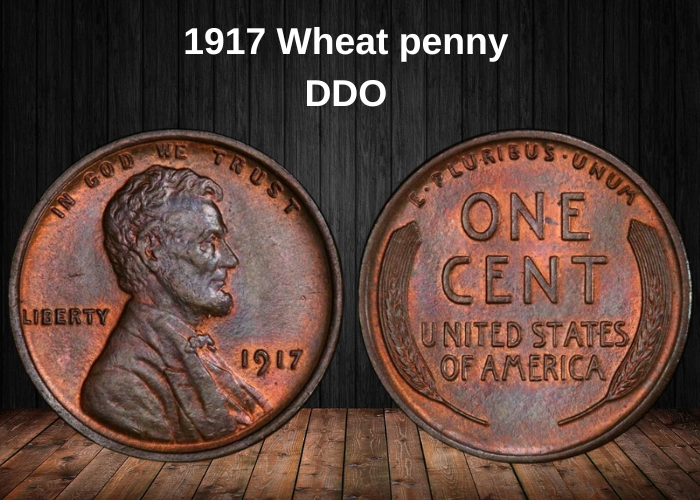
The 1917 Double Die Obverse pennies are highly sought-after collectibles, often commanding high prices. Even circulated examples can range in value from $100 to $2,640, while mint-state pieces typically fall between $2,750 and $7,200.
Red-brown coins are even more valuable, with prices varying from $8,750 to $12,500, depending on the grade (MS 63 to MS 65). However, the most prized are the fully red-toned cents from 1917, estimated at:
- MS 63 – $9,000
- MS 64 – $13,000
- MS 65 – $24,500
- MS 66 – $32,500
- MS 67 – $92,500
Auction records often surpass these valuations. The highest-known sale is the 1917 MS 67+ red penny with a DDO error, which sold for an astonishing $120,000 in 2019, making it the most valuable coin in the set.
Other 1917 penny errors
Apart from the well-known Double Die Obverse (DDO) error, the 1917 penny series includes several other interesting minting imperfections, such as:
- Die crack (die cud) errors – Valued between $3 and $150, depending on severity and location.
- Off-center errors – Typically priced from $10 to $20, with higher premiums for more dramatic shifts.
- Re-punched mint mark (RPM) errors – Available in the $5 to $20 range, depending on visibility and grade.
- Reverse struck-through errors – These can fetch anywhere from $10 to $100, based on the extent of the strike-through effect.
Each of these errors adds uniqueness and potential value to a 1917 penny, making them appealing to collectors.
Where to sell your penny?
Now that you know the value of your penny, you might be wondering where to sell it. Don’t worry: here’s a guide to some of the best online platforms where you can easily sell your coins, along with their advantages and disadvantages.
Discover the best platforms for selling coins online (pros and cons).



















































